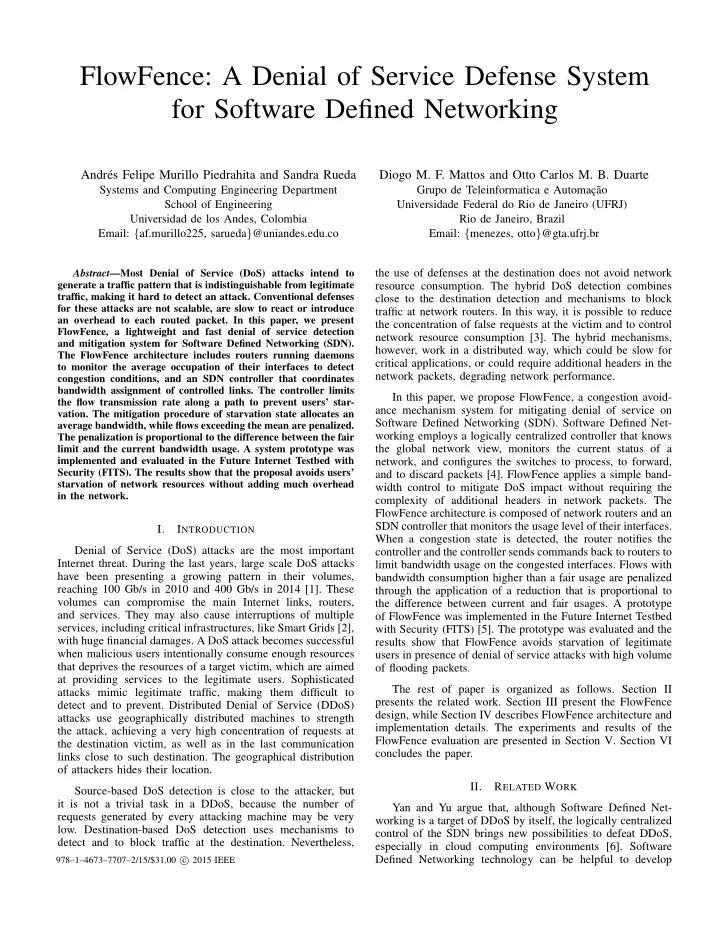

FlowFence: A Denial of Service Defense System for Software Defined Networking Andr´ es Felipe Murillo Piedrahita and Sandra Rueda Diogo M. F. Mattos and Otto Carlos M. B. Duarte Systems and Computing Engineering Department Grupo de Teleinformatica e Automac ¸˜ ao School of Engineering Universidade Federal do Rio de Janeiro (UFRJ) Universidad de los Andes, Colombia Rio de Janeiro, Brazil Email: { af.murillo225, sarueda } @uniandes.edu.co Email: { menezes, otto } @gta.ufrj.br the use of defenses at the destination does not avoid network Abstract —Most Denial of Service (DoS) attacks intend to generate a traffic pattern that is indistinguishable from legitimate resource consumption. The hybrid DoS detection combines traffic, making it hard to detect an attack. Conventional defenses close to the destination detection and mechanisms to block for these attacks are not scalable, are slow to react or introduce traffic at network routers. In this way, it is possible to reduce an overhead to each routed packet. In this paper, we present the concentration of false requests at the victim and to control FlowFence, a lightweight and fast denial of service detection network resource consumption [3]. The hybrid mechanisms, and mitigation system for Software Defined Networking (SDN). however, work in a distributed way, which could be slow for The FlowFence architecture includes routers running daemons critical applications, or could require additional headers in the to monitor the average occupation of their interfaces to detect network packets, degrading network performance. congestion conditions, and an SDN controller that coordinates bandwidth assignment of controlled links. The controller limits In this paper, we propose FlowFence, a congestion avoid- the flow transmission rate along a path to prevent users’ star- ance mechanism system for mitigating denial of service on vation. The mitigation procedure of starvation state allocates an Software Defined Networking (SDN). Software Defined Net- average bandwidth, while flows exceeding the mean are penalized. working employs a logically centralized controller that knows The penalization is proportional to the difference between the fair the global network view, monitors the current status of a limit and the current bandwidth usage. A system prototype was implemented and evaluated in the Future Internet Testbed with network, and configures the switches to process, to forward, Security (FITS). The results show that the proposal avoids users’ and to discard packets [4]. FlowFence applies a simple band- starvation of network resources without adding much overhead width control to mitigate DoS impact without requiring the in the network. complexity of additional headers in network packets. The FlowFence architecture is composed of network routers and an SDN controller that monitors the usage level of their interfaces. I. I NTRODUCTION When a congestion state is detected, the router notifies the Denial of Service (DoS) attacks are the most important controller and the controller sends commands back to routers to Internet threat. During the last years, large scale DoS attacks limit bandwidth usage on the congested interfaces. Flows with have been presenting a growing pattern in their volumes, bandwidth consumption higher than a fair usage are penalized reaching 100 Gb/s in 2010 and 400 Gb/s in 2014 [1]. These through the application of a reduction that is proportional to volumes can compromise the main Internet links, routers, the difference between current and fair usages. A prototype and services. They may also cause interruptions of multiple of FlowFence was implemented in the Future Internet Testbed services, including critical infrastructures, like Smart Grids [2], with Security (FITS) [5]. The prototype was evaluated and the with huge financial damages. A DoS attack becomes successful results show that FlowFence avoids starvation of legitimate when malicious users intentionally consume enough resources users in presence of denial of service attacks with high volume that deprives the resources of a target victim, which are aimed of flooding packets. at providing services to the legitimate users. Sophisticated The rest of paper is organized as follows. Section II attacks mimic legitimate traffic, making them difficult to presents the related work. Section III present the FlowFence detect and to prevent. Distributed Denial of Service (DDoS) design, while Section IV describes FlowFence architecture and attacks use geographically distributed machines to strength implementation details. The experiments and results of the the attack, achieving a very high concentration of requests at FlowFence evaluation are presented in Section V. Section VI the destination victim, as well as in the last communication concludes the paper. links close to such destination. The geographical distribution of attackers hides their location. II. R ELATED W ORK Source-based DoS detection is close to the attacker, but it is not a trivial task in a DDoS, because the number of Yan and Yu argue that, although Software Defined Net- requests generated by every attacking machine may be very working is a target of DDoS by itself, the logically centralized low. Destination-based DoS detection uses mechanisms to control of the SDN brings new possibilities to defeat DDoS, detect and to block traffic at the destination. Nevertheless, especially in cloud computing environments [6]. Software Defined Networking technology can be helpful to develop 978–1–4673–7707–2/15/$31.00 c � 2015 IEEE
Recommend
More recommend